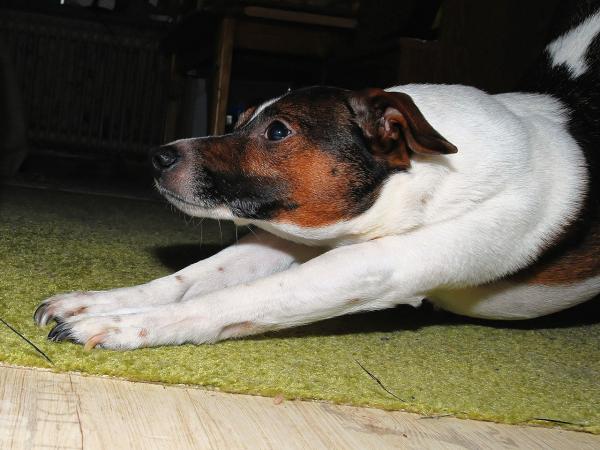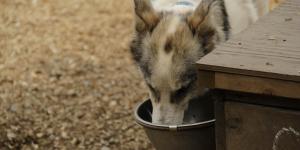My Dog is Stretching a Lot - Is It Normal?



See files for Dogs
When we adopt a dog, seeing them stretch is often adorable. They may stretch out on their bed, your bed, the grass or on the kitchen floor. It's a normal behavior which often shows they are tired or are emerging from a deep sleep. However, as with any behavior, if a dog is stretching a lot and seems as if they can't stop, it may be a sign of a problem. It is possible stretching too much may be a sign of a problem at the digestive, respiratory or even cardiac levels.
AnimalWised looks into the what is happening when your dog is stretching a lot. We look at when this is a normal behavior and when it may be a symptom of an underlying health issue.
Why do dogs stretch?
If we share our life with a dog, we will have seen them stretch on innumerable occasions. Commonly dogs will stretch in a way where they rest their paws on the ground, raise their rear and stretch out fully. They may also lean on their forelimbs to fully stretch their hindquarters. Once the dog stretches, it is also common for the dog to shake.
The reason for a dog stretching in these ways is the same as when we humans stretch. After resting for a long time, our muscles tighten and stretching allows us to limber up. Dogs are generally quite athletic, although some much more than others. For this reason, some will stretch more. The morphology of certain breeds might mean they stretch more. Greyhounds, for example, are very lithe and will need to stretch to stop their joints seizing.
Essentially dogs stretch to be more flexible. However, this need to be more flexible or to stretch out the body may be due to feeling uncomfortable.
There are many different postures which dogs adopt for various reasons. In our article, we explain more about why a dog lifts their front paw.
Dog doing downward dog stretch
There is a pose which almost all dogs do which looks like a stretch. They place their front paws on the ground, raise their ear and wag their tail. If you look carefully, however, you will see this is not an actual stretch. It is a pose which dogs perform to indicate to another animal or person that they want to play. They will have a happy expression and may even bark enthusiastically. It is the pose which is imitated by yoga practitioners and is known as the downward dog.
However, there is another downward dog pose that canines may exhibit. This one has a different purpose. It is known as an orthopneal pose and it is used to get more air into the lungs. It may also indicate that the dog is feeling pain and they ar stretching in this way to relieve said pain. There are variations of this pose whereby the dog is sitting down, but the basic purpose is the same. Below we detail some reasons why.

My dog stretches a lot and vomits
As we have explained, stretching is a very normal behavior in dogs. However, when it is abnormal, it is often accompanied by other symptoms. These may include vomiting, pain, bleeding or diarrhea. While we will need a professional veterinarian to confirm a diagnosis, the most common reasons for this include:
- Acute abdominal pain: this is considered a veterinary emergency and may be life threatening. The dog's belly becomes swollen and the dog experiences acute pain. The dog stretches as a means to relieve the pressure. They will also exhibit moaning, nausea, vomiting and/or respiratory problems. Without attention, the dog will go into shock. There are various causes including a ruptured organ, poisoning or obstruction. Requires surgical intervention.
- Gastroduodenal ulcers: these are often caused by the consumption of medication, specifically corticosteroids or NSAIDs such as ibuprofen. They can also be the result of kidney failure, liver failure or chronic gastritis. The affected dog will often show other symptoms such as vomiting blood, losing weight or having blood in their feces. The stretching posture helps to relieve discomfort.
- Chronic inflammatory bowel disease: the most common sign sin this pathology are vomiting, diarrhea, weight loss, changes in appetite and chronic pain. Again, the dog adopts the downward dog pose to relieve pain. It is believed to be caused by hypersensitivity to bacteria or food. Requires veterinary intervention.
- Gastric torsion: otherwise known as bloat, gastric torsion in dogs is also a veterinary emergency. It occurs when the stomach expands and twists round. Consequently, the dog will be nauseated, drool excessively and have a distended abdomen. When the dog exhibits pale mucus membranes, respiratory difficulty, fast heart rate and weakness, it means the dog is in serious trouble.
- Pancreatitis: this is inflammation of the pancreas which can occur in mild or severe cases. In the latter case, it will also involve vomiting and very strong abdominal pain. This is why the dog adopts the downward dog stretch. Diarrhea, dehydration and, eventually, shock will result. Pancreatitis in dogs also requires emergency treatment.

My dog stretches a lot and has labored breathing
While respiratory problems may also be symptoms of the above conditions, there are some more specific reasons why a dog will have labored breathing and stretch. The purpose is so the dog can get more oxygen into their body because the following disorders are preventing them from doing so:
- Severe pneumonia: this occurs especially in puppies, the elderly or individuals with severely compromised immune systems. Pneumonia in dogs results in a wet cough, fever, depression, rapid, breathing and often a runny nose with green mucus. In the most severe cases, the dogs sit with their heads extended and hind quarters out. This helps them to open up their chest and increase their lung capacity.
- Pleural effusion: this involves the accumulation of fluid in the chest and it has various underlying causes. it is similar to ascites in dogs, except in the chest rather than abdomen. The effusion makes it very difficult for the dog to breathe, do they stretch the help intake oxygen. The orthopneal posture the dog assumes will be either sitting or standing, but they will likely have their mouth open either way. The mucus membranes may have a bluish hue due to being deprived of oxygen. It is urgent and you will need to go to the veterinarian right away.
- Congestive heart failure: due to this disease (or range of diseases), the heart is unable to send blood to the rest of the body sufficiently. This causes a wide range of problems, including labored breathing. Heart failure will eventually affect all of the organs in the body. Symptoms concurrent with heart failure include lack of energy, weight loss and changes to blood pressure. The dog will continuously stretch to help inhale more air. The mucus membranes will also change color due to lack of origin. Take the dog to a veterinarian to confirm diagnosis.
As you can see, although stretching is a normal and healthy behavior in dogs, we need to ensure we look at any other symptoms. Doing so could save their life.

This article is purely informative. AnimalWised does not have the authority to prescribe any veterinary treatment or create a diagnosis. We invite you to take your pet to the veterinarian if they are suffering from any condition or pain.
If you want to read similar articles to My Dog is Stretching a Lot - Is It Normal?, we recommend you visit our Other health problems category.
- Baciero, G. (n.d.) Gastritis and other stomach pathologies, Axón Veterinaria, 26, 20-25.
- Carlson and Giffin. (2002). Practical canine veterinary manual. Madrid. Editorial El Drac.
- Crespo, C., Buendía and Ayala. (2015). Canine chronic inflammatory bowel disease. Endoscopic, biochemical and pathological findings of the anterior gastrointestinal tract. Veterinary Medicine Archives, 47(3).
- García-Sancho, Rodríguez-Franco, & Sainz. (2009). Chronic inflammatory disease of the small intestine of the dog. Comparison of activity indices. Complutense Journal of Veterinary Sciences, 3(1), 48-61.
- Jiménez and Gil. (2018). Gastric dilation-torsion syndrome. Veterinary Portal.







